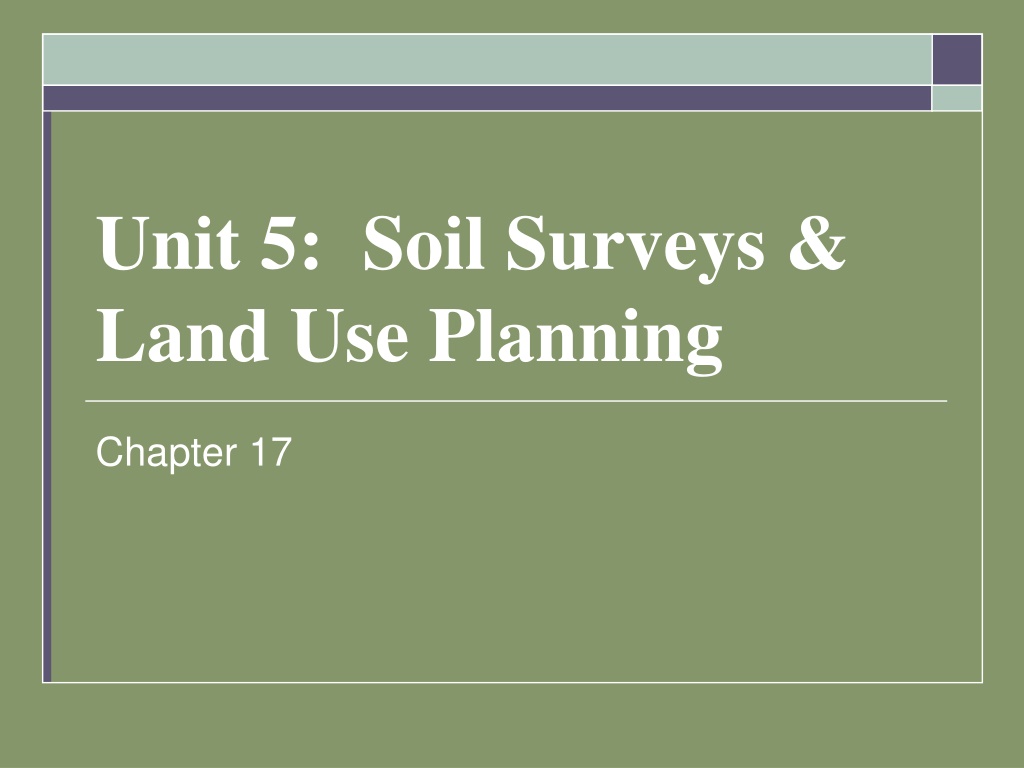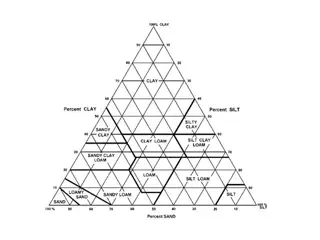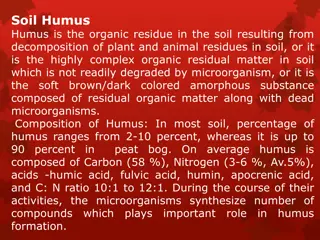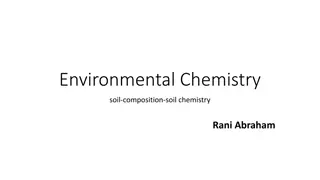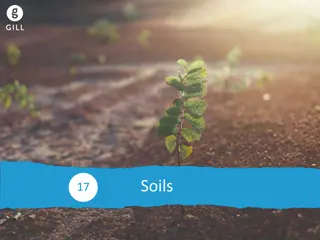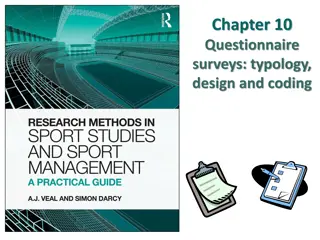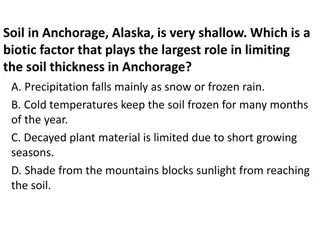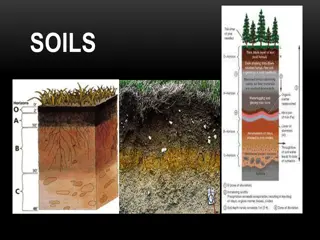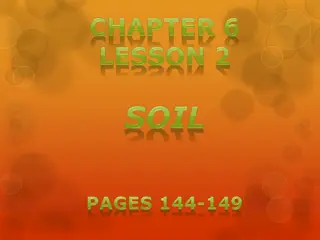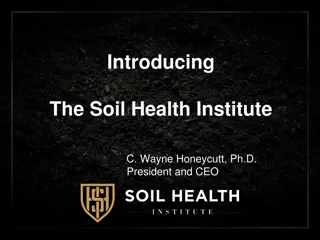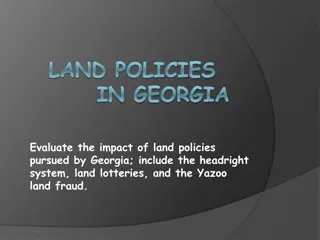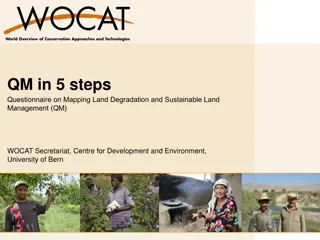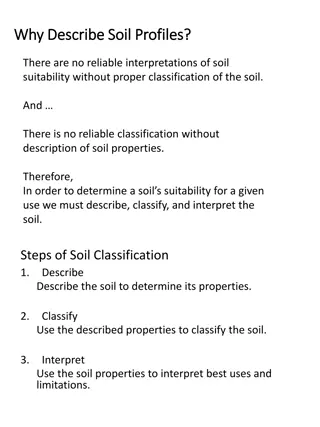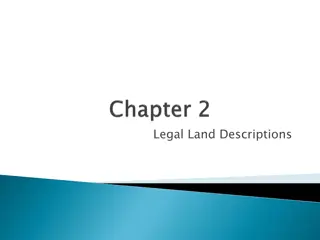Soil Surveys and Land Use Planning Insights
In Chapter 17, this document delves into the essential aspects of soil surveys and their significance in land use planning. It covers the objectives, methods of evaluation, and interpretation, highlighting the role of electronic databases. This resource provides a comprehensive overview of conducting soil surveys, from initial planning to report generation, emphasizing the importance of soil data for various stakeholders such as farmers, planners, engineers, and developers. Discover the process of delineating soil boundaries, predicting soil behaviors, and utilizing survey reports for different purposes like agricultural planning, construction site evaluations, and environmental assessments.
Uploaded on Feb 16, 2025 | 0 Views
Download Presentation

Please find below an Image/Link to download the presentation.
The content on the website is provided AS IS for your information and personal use only. It may not be sold, licensed, or shared on other websites without obtaining consent from the author.If you encounter any issues during the download, it is possible that the publisher has removed the file from their server.
You are allowed to download the files provided on this website for personal or commercial use, subject to the condition that they are used lawfully. All files are the property of their respective owners.
The content on the website is provided AS IS for your information and personal use only. It may not be sold, licensed, or shared on other websites without obtaining consent from the author.
E N D
Presentation Transcript
Unit 5: Soil Surveys & Land Use Planning Chapter 17
Objectives Knowledge of purposes & uses for soil surveys Identify tasks for soil survey & the reports involved Methods of soil evaluation & interpretation Use of electronic databases
Introduction Soil survey fact-finding mission, following by a report on the findings Description of the characteristics of the soils in a given area Classification of the soils Delineate boundaries of soils on a map Predictions of behaviors of the soils
Introduction Contain Data for many users Farmers, forecasters agronomists: evaluate potential production of the soil, management needs to maximize that potential Planners, community officials, engineers, developers, home buyers: evaluate the site for building construction purposes, strengths, limitations
Conducting a Soil Survey Before any surveying begins, a plan is made & information is collected Conferences Collect aerial photographs Satellite images Initial field reviews
Conducting a Soil Survey Preparation of a legend Initial field reviews conducted in soil pits in the most extensive landforms Soil-mapping unit: area of soil that is delineated from adjacent areas on a map Differences may be: Slope Erosion Soil profile
Soil Survey Reports Normally surveyed on a county basis Contents of a Soil Survey Temp & precipitation Spring/fall freeze dates Growing season Acreage & proportional extent of the soils Prime farmland Land capability & yields/ac of crops
Soil Survey Reports Rangeland productivity Recreational development potential Wildlife habitat Building site development Sanitary facility needs Construction materials Water management Engineering index
Soil Survey Reports Physical & chemical properties of the soils Soil & water features Chemical analysis Clay mineralogy Engineering index data Soil classification
Soil Survey Reports Mapping Legends for Soils Typically named for the most extensive soil series w/in each unit Each unit often a natural mixture of 2-5 soil-mapping units Called soil associations Delineations on the maps called phases of series
Soil Survey Reports Value of Detailed Soil Survey Reports Most soil properties recorded in a soil survey change very slowly Typically semiperminent properties: Land relief (topography) Soil texture Organic matter content Soil lime content Geologic origin
Soil Survey Reports Natural fertility Soil depth Tendency to accumulate soluble salts Soil structure Soil engineering properties Climate Natural vegetation Adapted crops & their expected productivity
Soil Survey Reports Reasons why a resurvey may be done: Some information was not gathered in a previous survey New management practices Changes in crops grown Yield prediction changes http://soils.usda.gov
Special Soil Designations Benchmark Soils Considered to be of great importance in an area Occupy a key position in the system of taxonomy ~1000 soils in the U.S. designated as benchmark soils Soil scientists hope that data from these soils can be extrapolated for soils for which less information is provided
Special Soil Designations Prime & Unique Farmland Lacking in many states due to many reasons Climate extremes Short growing seasons Mountainous terrain Some states contain lots of prime farmland Ex. Jewell Co., KS 67% prime farmland, Wayne Co., IN 74% prime farmland Some counties in IA - >90% farmland
Special Soil Designations Prime farmland soils Best suited to producing food, feed, forage, fiber, & oilseed crops Soil properties that lend themselves to sustained high yields Need to be treated & managed using acceptable farming practices Adequate moisture Growing season must be sufficiently long High yields w/ minimal inputs Least environmental damage
Land Evaluation Land-use planning done for: urban areas, rural areas Major issues: Quality of environment Environmental sustainability of ag production systems Pollution of nitrate, phosphate, pesticides Erosion of land Declining soil fertility
Land Evaluation Low-input farming Exploitation of timber & range resources Engineering use info Problems caused by these issues may have various/multiple facets Agronomic Economic Political Social
Land Evaluation LESA system Land Evaluation and Site Assessment Guide the conversion of farmland to urban uses Attempts to preserve the best farmland Three procedures: Land capability classification Current category of land is documented Soil rated according to capability
Land Evaluation Land Capability Classification Classification & sub classification for all soil- mapping units in the U.S. Class I Soils Can be used continuously for intensive crop production w/ good farming practices No restrictions Class II Soils More limitations than Class I land for crop production 2-5% slope is main difference
Land Evaluation Class III Soils Severe limitations Requires more special conservation practices than Class II to keep it continually productive Can have shallow soil Slopes 6-10% Shallow water tables
Land Evaluation Class IV Severe limitations for cropping use Greater intensity of conservation practices for cultivated crops that Class III Recommend permanent crops (e.g. pastures) Slope 12-18% Class V Boulders, wetness, problems impractical to correct Not necessarily erosion risk Can t be cultivated Use for pasture, range, woodland, wildlife habitat
Land Evaluation Class VI Slope 18-30% Same limitations as Class V soils, except more need for sustainable management practices Class VII Severe limitations Extreme care to protect the soil Even using grazing, wildlife, timber Slope >30%
Land Evaluation Class VIII Very severe limitations Steep slopes, rock lands, swamps, etc. Can only be used for wildlife, recreation, watersheds, aesthetic appreciation Land capability subclasses soil groups w/in the 8 classes that explain the reasons for limitations of intensive crop production e erosion hazard w - wetness
Land Evaluation s shallow, droughty, stony, permafrost c climate too cold or dry
Land Evaluation Ratings for Soil Potential Indicates the relative quality of a soil for a particular use compared with other soils in a given area Developed for planning purposes Supplement land capability classes, woodland suitability groups, range sites, soil limitation ratings
Land Evaluation Soil Potential Index (SPI) value assigned from 0-100 Yield/performance - sum of costs of corrective measures + costs for continuing limitations
Data Interpretation for Soil Uses Can be rated to have slight, moderate, severe limitations Severe Soil will require major soil reclamation, special design, high costs, or intensive soil maintenance to use for the item listed Very Severe Great difficulty in the soil s use, high costs, or both
Data Interpretation for Soil Uses Slight & Moderate May indicate problems w/: Shallow Low permeability Strong acidity High salt concentration Various other problems
Data Interpretation for Soil Uses Any soil may be good for one use, but poor for another Permeable, well-drained soil good for crops, poor for landfills, lagoons, etc. Clayey soil w/ good, deep drainage good for lagoons, ponds; difficult for cropping, unstable for roads, etc.
Controlling Land Use Much disagreement at all levels of government regarding how much control to impose on land use, and whether to develop or preserve natural resources Land-Use Laws & Customs Very difficult/controversial to control private property People generally agree that some controls are necessary, just don t agree on what they should be
Controlling Land Use <1% of U.S. population are farmers More prisoners than farmers in U.S. Land-use regulation began w/ 1926 Standard State Zoning Enabling Act Gave gov t right to zone areas for limited uses as protection to general public Zoning Laws local, regional, national gov t ability to guide land development
Controlling Land Use Easements & Contracts used by gov t bodies to implement land-use planning by mandatory action May demand easement or contract to purchase to specified reason (e.g. park) Easement/contract may be broken by gov t at any time w/ no penalty, but not by landowner Public Purpose nat l or state gov t have authority to purchase land for nat l/state forests, parks, hunting areas, flood control dams
Controlling Land Use Private Sales or Bequests land trusts & holding companies promising to protect the land Eminent Domain forced legal sale due to promotion of the general welfare of the public over private good Can force you to sell your land
Controlling Land Use Recent Trends in Land-Use Controls 1 million ac of prime ag land converted to non-ag uses each year in the U.S. This trend has prompted some states to pass laws to protect prime ag farmland Limited effectiveness No way for enforcement Preferential Tax Assessment made to fit current use of land instead of other uses that might be assessed at higher rates
Controlling Land Use Buying Development Rights owner sells development rights to gov t, but retains ownership to use at its current use Enforced Planning state requiring local gov ts to establish & enforce land-use planning, identify most productive farmland & housing growth areas
Controlling Land Use Threatened Farms & Farmers Priority for U.S. to have stable, wholesome, inexpensive food supply All 50 states have laws against urban sprawl, lawsuits that urban dwellers may bring against farmers for nuisances (odor, noise, dust) Called right-to-farm laws IA Supreme Court struck down this law in 1999 What is your reaction? What should we do to rectify the situation?
